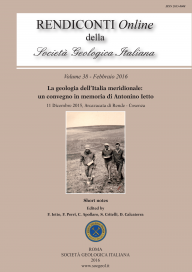
Quaternary carbonate deposition and climate variation (Tyrrhenian coast, Calabria, Southern Italy)
Edoardo Perri (a), Maria Pia Bernasconi (a) & Massimo Cefalà (a)
(a) Dipartimento di Biologia Ecologia e Scienze della Terra, Università della Calabria, Ponte Bucci 15b Rende, 87036 Rende (CS), Italy. Corresponding author e-mail: eperri@unical.it
Volume: 38/2016
Pages: 73-76
Abstract
A mid-latitude coralgal bioconstruction (Tyrrhenian coast of Calabria, Southern Italy) and associated sedimentary facies record climate and sea-level changes of this coastal area during the Pleistocene. The coralgal bioconstruction, characterized by Cladocora caespitosa bafflestone and red algae bindstone, associated with Spondylus gaederopus sp.-rich boundstone, formed as a result of submergence during Marine Isotope Stage 9 in a moderate shallow-marine environment at a depth of 6 - 20 m. The coast was affected by moderate to high-energy currents and occasional storms; the annual temperature was 12° - 18°C. The lower part of the coralgal body is dominated by Cladocora and the upper part by Lithophylloid algae. The change was likely the result of the occasional influx of coarse clastic material partially buried the C. caespitosa colonies, but provided a suitable substrate for the pioneer encrusting organisms. During a subsequent glacial stage, sea-level fall combined with tectonic uplift induced the partial emergence of the coralgal body, and deposition of an overlying subaerially-deposited breccia. A later resubmergence of the area, likely during the last interglacial period (MIS 5), is recorded as testified by the presence of endolithic microbialites in cavities within the coralgal bioconstruction and the breccia deposit. Microbialite formation took place in a marine environment with cooler water, with respect to the previous submergence phase, possibly during a time of early deglaciation. The low temperature, possibly combined with very shallow depths and an excess of nutrients, could have played a role in preventing further growth of C. caespitosa while favouring the precipitation of microbial carbonate.
Keywords
Get Full Text